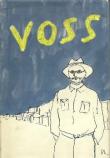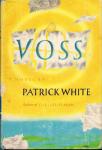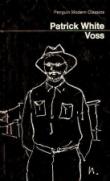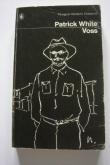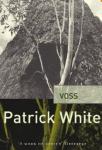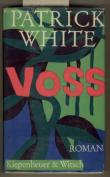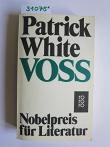AustLit
Latest Issues
AbstractHistoryArchive Description
'Set in nineteenth-century Australia, Voss is the story of the secret passion between an explorer and a naïve young woman. Although they have met only a few times, Voss and Laura are joined by overwhelming, obsessive feelings for each other. Voss sets out to cross the continent. As hardships, mutiny and betrayal whittle away his power to endure and to lead, his attachment to Laura gradually increases. Laura, waiting in Sydney, moves through the months of separation as if they were a dream and Voss the only reality.
'From the careful delineation of Victorian society to the sensitive rendering of hidden love to the stark narrative of adventure in the Australian desert, Patrick White's novel is a work of extraordinary power and virtuosity.'
Source: Random House Books (Sighted 21/09/2012)
Adaptations
-
y
 Voss : Opera in Two Acts After the Novel by Patrick White
Richard Meale
(composer),
Grosvenor Place
:
Australian Music Centre
,
1980-1989
Z272889
1980-1989
single work
musical theatre
opera
Voss : Opera in Two Acts After the Novel by Patrick White
Richard Meale
(composer),
Grosvenor Place
:
Australian Music Centre
,
1980-1989
Z272889
1980-1989
single work
musical theatre
opera
Voss was adapted into an opera by author David Malouf and composer Richard Meale. It was first performed by the Australian Opera in Adelaide, March 1986.
Notes
-
Dedication: For Marie d'Estournelles de Constant
-
In a letter to Hu Wenzhong, White refers to a Russian edition, but this has not been traced.
Publication Details of Only Known VersionEarliest 2 Known Versions of
Other Formats
- Also braille and sound recording.
Works about this Work
-
Uluru : A Rock That Plagues Australia’s Conscience
2021
single work
column
— Appears in: The Guardian Australia , 24 May 2021;'Mark McKenna’s short, elegant book Return to Uluru gazes inwards to the continental interior, metaphor for a nation’s yearning.'
-
Nothing to Be Done
2020
single work
column
— Appears in: The Times Literary Supplement , 21 February 2020; (p. 24-25) -
What I’m Reading
2019
single work
column
— Appears in: Meanjin Online 2019; -
y
 Voss : An Australian Geographical and Literary Exploration
Berne
New York (City)
:
Peter Lang
,
2019
20916361
2019
multi chapter work
criticism
Voss : An Australian Geographical and Literary Exploration
Berne
New York (City)
:
Peter Lang
,
2019
20916361
2019
multi chapter work
criticism
'This study of Voss by the Anglo-Australian Patrick White analyses the historical novel, set in the 1850s and concerning Voss’s exploration of the interior of Australia, as a parable of the writer’s exploration of the Australian historical, social and cultural context of the 1950s. The study employs a variety of critical apparatus including a post-structuralist and postcolonial approach, which also encompasses linguistics, sociolinguistics and comparative studies. This multi-level critical aid allows the examination of four levels of exploration utilised by the author.
'Following an analysis of the protagonist’s geographical movement into the desert and his personal transformation, the study moves on to an exploration of the narrative itself. It explores how the novel becomes subject to change, absorbing and contesting a variety of literary genres ranging from the ‘chronicle’ to the parable. Through this multi-level approach, the study demonstrates the variety of readings the novel stimulates and displays its rich intertextual and subtextual elements and links.' (Publication summary)
-
Australien
2019
single work
criticism
— Appears in: Verdenslitteraturer : Introduktion til litteraturen uden for Europa 2019; (p. 253-284)
-
[Review] Voss
2006
single work
review
— Appears in: 1001 Books You Must Read Before You Die 2006; (p. 509)
— Review of Voss : A Novel 1957 single work novel -
The Books That Made Us
1995
single work
review
— Appears in: The Weekend Australian , 19-20 August 1995; (p. rev 1-2)
— Review of My Brother Jack : A Novel 1964 single work novel ; The Lucky Country 1964 single work non-fiction ; Joe Wilson and His Mates 1901 selected work short story ; My Brilliant Career 1901 single work novel ; Monkey Grip 1977 single work novel ; Voss : A Novel 1957 single work novel ; The Fortunes of Richard Mahony 1917 single work novel -
Novelists and Conventions
1958
single work
review
— Appears in: Prospect , June vol. [1] no. 1 1958; (p. 21-22)
— Review of Seedtime 1957 single work novel ; Voss : A Novel 1957 single work novel -
'Seedtime' and 'Voss'
1958
single work
review
— Appears in: Meanjin , Autumn vol. 17 no. 1 1958; (p. 94-100)
— Review of Seedtime 1957 single work novel ; Voss : A Novel 1957 single work novel -
[Review] Voss
1957
single work
review
— Appears in: The Times Literary Supplement , 13 December 1957; (p. 753)
— Review of Voss : A Novel 1957 single work novel -
The Marriage of the Mind and the Cosmos in Patrick White's Voss : An Indian Perspective
2002
single work
criticism
— Appears in: The Literary Criterion , vol. 37 no. 2 2002; (p. 44-53) -
Inner Struggles
2002-2003
single work
criticism
— Appears in: The Bulletin , 17 December-14 January vol. 120 no. 6355 2002-2003; (p. 38-39) -
Paradoxes of Non- Existence : Questions of Time, Metaphor and the Materialities of Cultural Traditions in Wilson Harris's Discussions of Australian Literary Texts
2002
single work
criticism
— Appears in: Australian Cultural History , no. 21 2002; (p. 81-88, notes 122) Olubas examines the way in which Caribbean writer Wilson Harris's 'account of national traditions and of the national and cultural provenances and imaginitive inheritances of particular writers directs attention ... toward broader, unexpected imaginitive, aesthetic and representational traditions, explicitly colonial, often violent, which yet enhance our readings of the complex high points of national literary traditions and figures ... [and] presents us with other ways to take up the relations between texts, within as well as across (national) cultural traditions' (p. 88). -
Containing Continents: The Moralized Landscapes of Conrad, Greene, White and Harris
1985
single work
criticism
— Appears in: Kunapipi , vol. 7 no. 1 1985; (p. 34-45) -
y
 Postcolonial Literature from Three Continents : Tutuola, H. D., Ellison, and White
New York (City)
:
Peter Lang
,
2003
Z1061297
2003
multi chapter work
criticism
Publisher's abstract: 'How can we read literatures from other cultures? The metaphors of fractal geometry can help us think about the complexity of the cultural situation of a text or an author. Postcolonial Literature from Three Continents identifies four primary themes common to postcolonial texts - technology, memory, language, and geography - and examines them in relationship to four texts from Nigeria, the United States, and Australia so that we see both the colonized and colonizing positions of these works. The quartet of texts are Amos Tutola's The Palm-Wine Drinkard, H. D.'s Helen in Egypt , Ralph Ellison's Invisible Man, and Patrick White's Voss.'
Postcolonial Literature from Three Continents : Tutuola, H. D., Ellison, and White
New York (City)
:
Peter Lang
,
2003
Z1061297
2003
multi chapter work
criticism
Publisher's abstract: 'How can we read literatures from other cultures? The metaphors of fractal geometry can help us think about the complexity of the cultural situation of a text or an author. Postcolonial Literature from Three Continents identifies four primary themes common to postcolonial texts - technology, memory, language, and geography - and examines them in relationship to four texts from Nigeria, the United States, and Australia so that we see both the colonized and colonizing positions of these works. The quartet of texts are Amos Tutola's The Palm-Wine Drinkard, H. D.'s Helen in Egypt , Ralph Ellison's Invisible Man, and Patrick White's Voss.'
Awards
- 1959 winner W.H. Smith Literary Award (UK)
- 1957 winner Miles Franklin Literary Award
- Geographic isolation
- Human condition
- Aboriginal-White conflict
- Power (Personal relations)
- Death
- Suffering
- Isolation (Emotional & social)
- Separation
- Loss
- Exploration & explorers of Australia (Land)
- Country vs city
- Deserts
- Love
- German people
- Hardship & deprivation
- Alienation
- Pilgrimages & journeys
- Colonial life
- Integrity
- Pastoral industry
- Australian Outback, Central Australia,
- ca. 1840-1860
- Sydney, New South Wales,
- Queensland,



